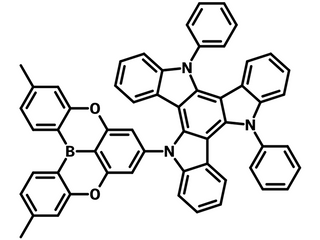mMDBA-DI
CAS Number 2770257-85-5
Dopant Materials, Fluorescent Host Materials, High Purity Sublimed Materials, Host Materials, Materials, MR-TADF Materials,Blue MR-TADF Emitter, Suitable for Hyperfluorescent OLEDs
High purity sublimed narrowband multi-resonance TADF emitter for highly efficient OLEDs, Hyperfluorescence, CAS 2770257-85-5, Sublimed >99%
mMDBA-DI, namely 5-(3, 11-dimethyl-5,9-dioxa-13b-boranaphtho[3,2,1-de]anthracen-7-yl)-10,15-diphenyl-10,15-dihydro-5H-diindolo[3, 2-a:3′, 2′-c]carbazole, is a D-A type MR-TADF emitter that features a faster kRISC of 1.5 × 106 s−1. Among the developed TADF sensitizers, the mMDBA-DI demonstrates deep blue color with a high horizontal dipole orientation ratio of 0.82 and PLQY of 97.8%. mMDBA-DI has large spectrum overlap with v-DABNA, hyperfluorescence (HF) device with mMDBA-DI exhibits EQEmax of 39.9% with max electroluminescence of 474 nm and 19 nm of FWHM.
Also, Hyperfluorescence device based on TADF host material, mMDBA-DI, and a pure blue multi-resonance type tert-butyl substituted TADF fluorescence emitter t-Bu-ν-DABNA exhibits a high external quantum efficiency of 39.1% along with narrow emission with full width at half maximum of 19 nm (CIE y = 0.15).
General Information
| CAS Number | 2770257-85-5 |
|---|---|
| Chemical formula | C56H36BN3O2 |
| Molecular weight | 793.73 g/mol |
| Absorption* | λmax 371 nm (in toluene) |
| Fluorescence | λem 451 nm (in toluene) |
| HOMO/LUMO | HOMO = 5.48 eV, LUMO = 2.57 eV (ΔEST = 0.12 eV) |
| Synonyms | 5-(3,11-Dimethyl-5,9-dioxa-13b-boranaphtho[3,2,1-de]anthracen-7-yl)-10,15-diphenyl-10,15-dihydro-5H-diindolo[3,2-a:3',2'-c]carbazole |
| Classification or Family | Triaryboron derivatives, Diindolo[3,2-a:3',2'-c]carbazole, TADF host, Blue dopant, Multiresonance thermally activated delayed fluorescent (MR-TADF), Sublimed materials. |
Product Details
| Purity | Sublimed* >99% (HPLC) |
|---|---|
| Melting point | Td = 470 °C |
| Appearance | White powder/crystals |
* Sublimation is a technique used to obtain ultra pure-grade chemicals, see sublimed materials for OLED devices.
Chemical Structure

Device Structure(s)
| Device structure | ITO (50 nm)/HATCN (7 nm)/TAPC (50 nm)/DCDPA* (10 nm)/DBFPO:30% mMDBA-DI (25 nm)/DBFPO (5 nm)/TPBi (20 nm)/LiF (1.5 nm)/Al (100 nm) [1] |
|---|---|
| Colour |
|
| Max Current Efficiency | 38.2 cd/A |
| FWHM | 60 nm |
| Max EQE | 31.8% |
| Device structure | ITO (50 nm)/HATCN (7 nm)/TAPC (50 nm)/DCDPA* (10 nm)/DBFPO:30% mMDBA-DI:5% t-Bu-ν-DABNA (25 nm)/DBFPO (5 nm)/TPBi (20 nm)/LiF (1.5 nm)/Al (100 nm) |
|---|---|
| Colour |
|
| Max Current Efficiency | 30.3 cd/A |
| FWHM | 19 nm |
| Max EQE | 39.1% |
*For chemical structure information, please refer to the cited references.
MSDS Documentation
Literature and Reviews
- K. Naveen et al. (2022); Achieving High Efficiency and Pure Blue Color in Hyperfluorescence Organic Light Emitting Diodes using Organo-Boron Based Emitters, Adv. Funct. Mater., 32 (12); 2110356; DOI: 10.1002/adfm.202110356.
- E. Tankelevičiūtė et al. (2024); The Blue Problem: OLED Stability and Degradation Mechanisms, J. Phys. Chem. Lett., 15 (4), 1034-1047; DOI: 10.1021/acs.jpclett.3c03317.
- M. Huang et al. (2024); Harmonization of rapid triplet up-conversion and singlet radiation enables efficient and stable white OLEDs, Nat. Commun., 15, 8048; DOI: 10.1038/s41467-024-52401-7.
- Y. Gawale et al. (2023); Forthcoming hyperfluorescence display technology: relevant factors to achieve high-performance stable organic light emitting diodes, Front. Chem., 11, 1211345; DOI: 10.3389/fchem.2023.1211345.


 mMDBA-DI MSDS Sheet
mMDBA-DI MSDS Sheet